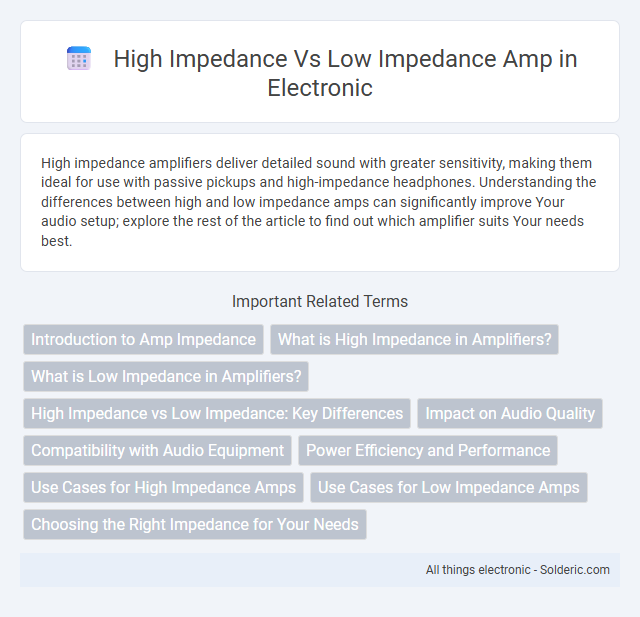High impedance amplifiers deliver detailed sound with greater sensitivity, making them ideal for use with passive pickups and high-impedance headphones. Understanding the differences between high and low impedance amps can significantly improve Your audio setup; explore the rest of the article to find out which amplifier suits Your needs best.
Comparison Table
| Feature | High Impedance Amplifier | Low Impedance Amplifier |
|---|---|---|
| Input Impedance | Typically above 1 MO | Below 10 kO |
| Signal Source | Ideal for high impedance sources like piezo pickups | Better for low impedance sources such as dynamic microphones |
| Noise Sensitivity | Higher noise susceptibility | Lower noise susceptibility |
| Frequency Response | May roll off at high frequencies if cable is long | Stable frequency response over long cables |
| Power Consumption | Generally lower | Generally higher |
| Applications | Instrument amplifiers, acoustic pickups | Professional audio, PA systems |
| Load on Source | Minimal load due to high impedance | Heavier load on source |
Introduction to Amp Impedance
Amplifier impedance is a critical parameter that affects the compatibility and performance between an amplifier and connected speakers or headphones. High impedance amps typically operate at 600 ohms or above, delivering cleaner sound with reduced distortion when matched with high impedance headphones or speakers. Low impedance amps, ranging from 4 to 32 ohms, provide higher current output suitable for driving low impedance devices, ensuring louder volume and better control over speaker cones.
What is High Impedance in Amplifiers?
High impedance in amplifiers refers to an input or output resistance typically above 10,000 ohms, which affects how electrical signals are transferred and matched with connected devices. High impedance inputs minimize current draw from the signal source, preserving signal integrity and preventing tone loss, especially important for guitar pickups and microphones. Understanding your amplifier's impedance ensures optimal compatibility with instruments and audio equipment, enhancing sound quality and performance.
What is Low Impedance in Amplifiers?
Low impedance in amplifiers typically refers to an output impedance of less than 8 ohms, allowing the amplifier to deliver higher current to speakers with low resistance. Your amplifier's low impedance output ensures better power transfer, reduced signal loss, and improved sound quality for speakers rated at 4 to 8 ohms. This characteristic is crucial for achieving optimal performance in home audio systems, professional sound setups, and portable devices.
High Impedance vs Low Impedance: Key Differences
High impedance amplifiers typically feature input impedances above 10 kilo-ohms, causing less signal loss and preserving tone in electric guitars and passive pickups, while low impedance amplifiers, usually below 1 kilo-ohm, provide stronger signal transfer and better noise rejection for microphones and balanced sources. The main difference lies in impedance matching: high impedance devices are optimized for high-impedance sources to maintain signal integrity, whereas low impedance amps suit low-impedance sources for improved signal strength and reduced interference. Selecting the correct impedance type enhances audio fidelity, reduces signal degradation, and ensures optimal performance across various audio equipment configurations.
Impact on Audio Quality
High impedance amplifiers typically offer greater voltage output with less current, resulting in clearer sound reproduction with minimal distortion for high-impedance headphones and speakers. Low impedance amplifiers provide stronger current delivery, enhancing dynamic range and bass response, especially with low-impedance drivers that require more power. Matching amplifier impedance to the audio device ensures optimal signal transfer, preventing frequency attenuation and preserving the integrity of audio quality.
Compatibility with Audio Equipment
High impedance amplifiers typically require matching with speakers or headphones that have high impedance ratings, often above 250 ohms, to ensure optimal sound quality and prevent signal loss. Low impedance amplifiers are designed to work efficiently with low impedance audio equipment, usually between 4 to 32 ohms, making them compatible with most consumer-grade speakers and headphones. Using mismatched impedance between an amplifier and audio equipment can result in reduced audio performance, increased distortion, and potential damage to the components.
Power Efficiency and Performance
High impedance amps typically exhibit lower current flow, resulting in higher voltage but reduced power efficiency compared to low impedance amps, which draw more current and deliver greater power output. Low impedance amplifiers provide better performance in driving demanding loads, producing stronger, clearer sound and improved dynamic range. Power efficiency in low impedance amps is often enhanced by advanced circuit designs, making them suitable for high-performance audio systems requiring both power and fidelity.
Use Cases for High Impedance Amps
High impedance amplifiers are ideal for use with passive guitar pickups, electrostatic microphones, and various sensors that produce weak signals requiring minimal loading to preserve tone and accuracy. They excel in applications demanding high input impedance, typically in the megaohms range, preventing signal attenuation and maintaining sound clarity. These amps are preferred in studio recording environments and live sound setups where signal integrity from high-impedance sources is critical.
Use Cases for Low Impedance Amps
Low impedance amplifiers, typically rated between 4 to 8 ohms, are ideal for driving standard loudspeakers in home audio systems, professional PA setups, and studio monitors, ensuring efficient power transfer and minimal signal loss. These amps excel in scenarios requiring robust sound output and consistent performance across common speaker loads, making them suitable for versatile audio environments. Low impedance amps also provide better protection against speaker damage, maintaining audio fidelity in dynamic sound applications.
Choosing the Right Impedance for Your Needs
Choosing the right impedance for your needs depends on matching your amplifier with your speakers to ensure optimal power transfer and sound quality. High impedance amplifiers are ideal for driving long cable runs with minimal signal loss, while low impedance amplifiers deliver more current and are suitable for speakers requiring greater power output. Understanding your audio setup and speaker specifications can help you select the appropriate impedance, enhancing your overall listening experience.
High impedance vs Low impedance amp Infographic

 solderic.com
solderic.com